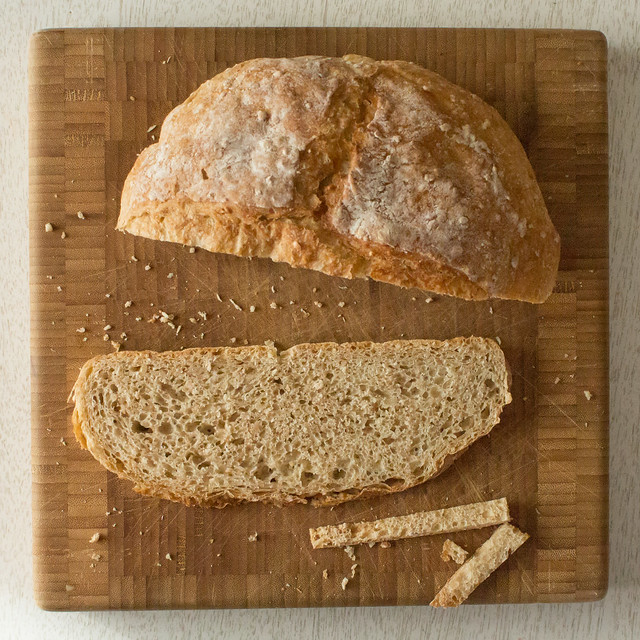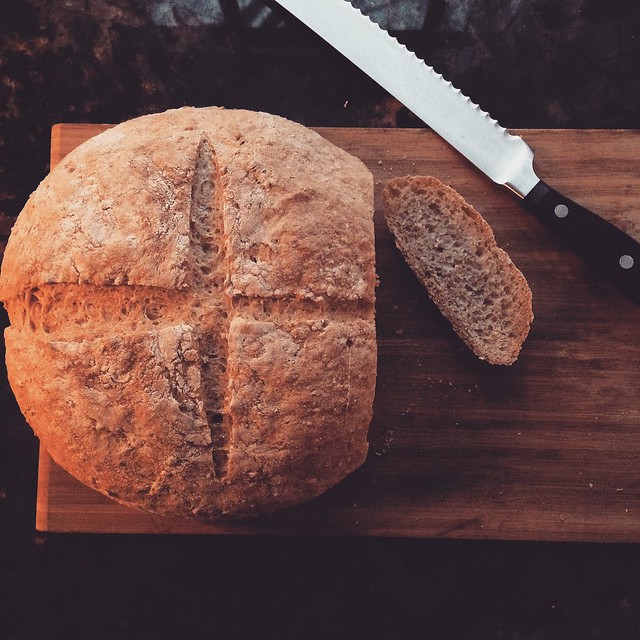I’ve said before that the time frame between Christmas and New Year’s Day seems like bonus time to me. Like the 52nd week in the year is a free space on the calendar that simply exists for me not to put anything into. There is always ample food. And sweets: those are always even more plentiful than actual sustenance. I find that I eat often, too much, and continually all at once, and getting back to a more austere schedule with a brand new year ahead is always a very welcome sight.
But being interested in food means that the end of a year also signals a slew of “best of” lists and new year in food predictions. The last week of the year and even the first few of the new one I spend in my own mind reflecting on my favorite things in my personal kitchen, what new cookbooks I can’t imagine living without, even what old year recipes were on my radar but never seemed to materialize.
For the past 2 years, I kept track of every loaf of sourdough bread I baked by photographing them and putting them in flickr albums. This year in review got me thinking about how our appetites wax, wane, and change, and how my solid wild yeast addiction has changed over the years from my first intrepid loaves back in 2010.
I logged 114 loaves of wild bread in 2014, and only 83 this past year. The odd 30 loaf change spurred me to thinking about my bakery habits. My daily life has changed enough that bread isn’t as romantic as it used to be, it’s more methodical and dutiful. I don’t enjoy it any less, but it is a hard fact that the time I once had for experimentation and 3 days cultivation has temporarily left me. I’ve made more quick breads, many (many) more tortillas, and towards the end of 2015 huge batches of whole wheat chapatis thanks to Hot Bread Kitchen.
While I still feel that long, slow bread is best, I also have cut myself some slack in the whole foods prep department. I do not have the time to soak every almond and walnut, I do not have the time to even keep a yogurt culture from dying out on me and I’m going to say that is okay. I also know that “quick” yeast bread that came out of my kitchen is (in my opinion anyway) infinitely more healthy than planning a trip to and picking out a store bread devoid (for the most part) of character. There are good bakeries out there, there are good bakeries here in Milwaukee! But there is still something about bread coming from my own hands, by way of my cheap (but oh so accurate) Hotpoint oven that I will never get over.
It’s what gives me the soul of a baker I think, that as the years pass it’s the one constant I insist I produce myself.
Instead of a 2016 sourdough only flickr album, I’ve decided to include all breads (I’ll omit flatbreads - unless something really stands out - since they are last minute additions to a meal and let’s face it, we need to eat!). This is the first loaf of 2016, which brings me all the way back to the beginning of my bread baking life (I still have Jeff Herzberg and Zoe Francois' first 2 books). A friend of my mom gave her a “loaf of bread in a jar” gift for Christmas, and we baked it when I was visiting. The flour was a blend of coarsely ground wheat and plain old AP, but it tasted so good. And I didn’t even weigh the ingredients! When I double checked, I found that it was a ratio from Artisan Bread in 5 Minutes a Day which were the first hearth-style loaves that I ever made. I hadn’t revisited it in years, perhaps due to my bread snobbery, but it has a place in my kitchen once again.
What’s interesting is that I never baked Artisan Bread in 5 Minutes a Day right after the first rise, I always aged it in the fridge for a few days. Baked fresh, and with freshly ground flour, it has the simplicity of a soda bread and a soft and nubby texture. It’s crust is soft too, and while I do miss the chew of my old bread, this is nice for sandwiches, for toast, for 2 year olds with problems chewing his food well enough sometimes.
My ratio for a single loaf was 3 oz. coarsely ground spelt, 3 oz. whole wheat flour, and 10 oz. AP flour. Mix in a generous teaspoon of salt (more if you like saltier bread), 2 1/4 t. instant commercial yeast, and 1 1/2 cups 100 degree water and mix well - but don't focus on kneading. Cover the bowl and let it rest at room temperature for about 2 hours until it has risen at least double. Transfer the dough to a well floured surface and form into a round loaf. Let the loaf rise at room temperature (I like to let it rest on a sheet of parchment for ease of transport), and when a gentle finger poke shows an indent that doesn't pop back score simply, since there won't be a ton of oven spring, and immediately bake in a preheated 450 degree oven for 30 minutes or so until nicely browned and hollow sounding. (Internal temp should be around 200 degrees.)
I baked in without a pot (transferred with the parchment to a sheet pan) at my parents' house and the crust was about the same as when I baked in a preheated iron pot with a lid on. If you choose to bake it in a pot, bake it for 20 minutes with the lid on, then remove the whole loaf from the pot and finish baking for 10-15 minutes directly on the oven rack.
I've never included a detailed list of my year end favorites, but I think I'll give it a go since I read a number of really lovely baking books this year. I'm sure it's far from complete as there were titles I probably didn't get to or know about in 2015, and unfortunately some I may have forgotten. Some of these are may be older but I read them for the first time last year. Going forward to 2016 with a broader world view of bread once again, I'm excited to dig in and bake a little more liberally from some of these! Happy 2016 to you!
(In no particular order:)
- Hot Bread Kitchen, by Jessamyn Waldman Rodriguez & Julia Turshen
- Breads of the Southwest: Recipes in the Native American, Spanish, and Mexican Traditions, by Beth Hensperger
- Baking with Less Sugar, by Joanne Chang
- The New Sugar and Spice, by Samantha Seneviratne
- Ovenly: Sweet and Salty Recipes from New York's Most Creative Bakery, by Erin Patinkin and Agatha Kulaga
- Huckleberry: Stories, Secrets, and Recipes From Our Kitchen by Zoe Nathan with Josh Loeb and Laurel Almerinda
- Ciao Biscotti: Sweet and Savory Recipes for Celebrating Italy's Favorite Cookie Hardcover, by Domenica Marchetti
- Fika: The Art of The Swedish Coffee Break, with Recipes for Pastries, Breads, and Other Treats, by Anna Brones
- Bread Revolution: World-Class Baking with Sprouted and Whole Grains, Heirloom Flours, and Fresh Techniques, by Peter Reinhart
- Flavor Flours: A New Way to Bake with Teff, Buckwheat, Sorghum, Other Whole & Ancient Grains, Nuts & Non-Wheat Flours. by Alice Mendrich



